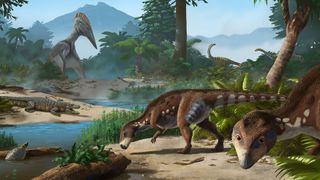The new “dwarf dinosaur” species lends more evidence to the “island rule,” which posits that animals evolving on islands become smaller than their mainland counterparts.

Fossil evidence suggests that during the Cretaceous era, “dwarf dinosaurs” populated a tropical archipelago near modern-day Romania. (Image credit: Peter Nickolaus)
If you think of Transylvania, you might imagine a place populated by vampires and werewolves. Now, you can add “dwarf dinosaurs” to that list. A group of researchers recently identified a new species of dinosaur from the region, dubbing it Transylvanosaurus platycephalus, or, “flat-headed reptile from Transylvania.” And it’s part of a group of dwarf dinosaurs that evolved to be much smaller than their relatives.

T. platycephalus, a member of the Rhabdodontidae family — a group of herbivorous ornithopod dinosaurs — lived about 70 million years ago during the late Cretaceous period (145 million to 66 million years ago). At this point in Earth’s past, flowering plants had evolved — and with them the first pollinators — and birds’ ancient ancestors were just beginning to experiment with flying. The massive supercontinent Pangea had broken up into several smaller continents and Europe was an archipelago of tropical islands, more like modern-day Indonesia or the Galápagos.
In a new study, published online Nov. 23 in the Journal of Vertebrate Paleontology, the researchers described the newfound species from bone fragments from the forehead and from the lower back portion of the skull. In life, T. platycephalus would have measured just 6.5 feet (2 meters) long. It had a wide, flat head and lived alongside other reptiles, such as crocodiles and turtles.

Prior research suggested that dinosaur diversity had already significantly declined by this point in Earth’s history, just prior to the mass extinction that ended the Cretaceous. But this new finding may suggest that diverse dinosaur forms were still very much a part of Cretaceous Europe’s landscape.
“With each newly-discovered species we are disproving the widespread assumption that the Late Cretaceous fauna had a low diversity in Europe,” Felix Augustin, lead study author and a doctoral candidate at the University of Tübingen in Germany, said in a statement.

Skull bones of the Transylvanosaurus (Image credit: Dylan Bastiaans)
And the dinosaur’s diminutive size makes it the newest member of the so-called dwarf dinosaur family found in Romania’s Hateg region (Transylvania is the historical and cultural name for the region in central Romania). The Hateg dwarf dinosaurs are an infamous group of dinosaurs that have captivated paleontologists since their discovery in the early 20th century. In 2010, another group of researchers determined that during the late Cretaceous, an island spanning about 30,900 square miles (80,000 square kilometers) lay in the Hateg region where these dwarf dinosaurs have been found.

Islands commonly produce smaller-than-usual species. Today, there are dwarf lemurs on an island in Northern Madagascar and dwarf foxes in the California Channel islands. Ten thousand years ago, dwarf elephants and dwarf hippos lived on islands in the Mediterranean. In a study published in 2021 in the journal Nature Ecology and Evolution, researchers analyzed thousands of reports of body size changes for over a thousand species and found that “the island rule” generally holds true — over generations, large animals tend to become smaller when they’re isolated on an island.
There are a few hypotheses behind why animals shrink on an island. It could be that the lack of large predators allows animals to stay small, evolutionary anthropologist Caitlin Schrein wrote in 2016 in the anthropology magazine Sapiens. Island ecosystems may offer less variety in food, perhaps leading to stunted growth in some animals, Schrein wrote. And if there are no large predators on the island, those smaller animals won’t be removed from the population.

During the late Cretaceous, Rhabdodontidae dinosaurs were the most common small-to-medium herbivores in what is now Europe. In the new study, the researchers noted that relatives of T. platycephalus have been found in modern-day France, which at the time would have been a separate island. As the archipelago formed and sea levels fluctuated, land bridges between islands could have allowed the dinosaurs to spread out and evolve in isolation from each other.
They might even have dispersed between islands by swimming short distances, Augustin suggested. Dinosaurs “had powerful legs and a powerful tail. Most species, in particular reptiles, can swim from birth,” Augustin said.